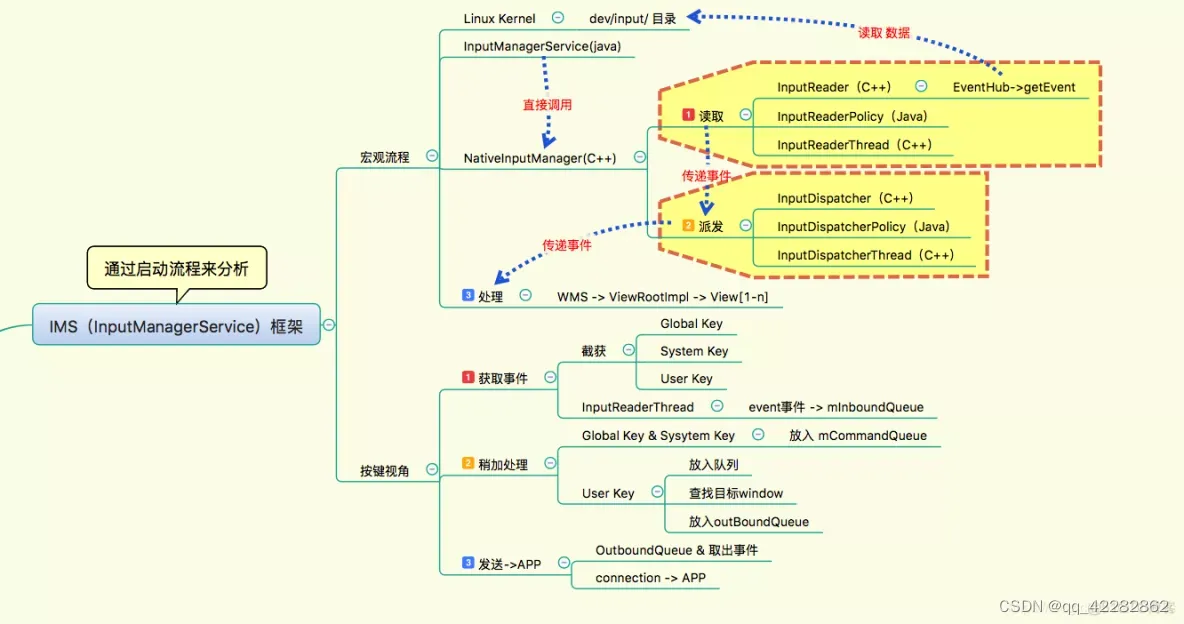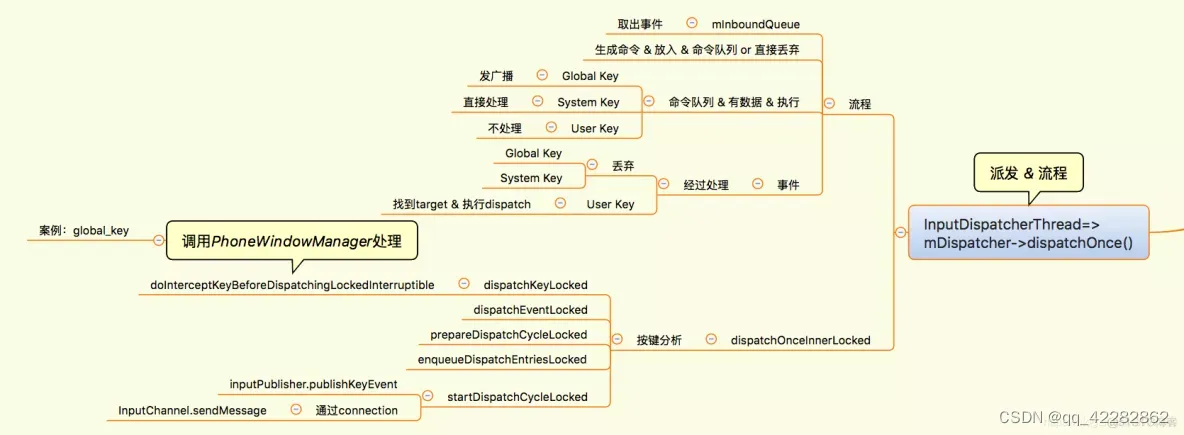Input系统之InputDispatcher


这里新增加了 按键视角部分,以按键的流程来解读整个IMS的数据流走向的框架。新增的派发数据流程截图如下

Dispatcher对按键的处理流程关键点解析
- 通用模型的处理流程
回顾key的处理流程,关键点在于这段代码
//InputReader的分析:KeyboardInputMapper::processKey中数据最后同步到dispatcher中流程:NotifyKeyArgs args(when, getDeviceId(), mSource, policyFlags,down ? AKEY_EVENT_ACTION_DOWN : AKEY_EVENT_ACTION_UP,AKEY_EVENT_FLAG_FROM_SYSTEM, keyCode, scanCode, newMetaState, downTime);//说明:这里getListener是InputReader初始化时传入的对象,即InputDispatchergetListener()->notifyKey(&args);
这里继续分析notifyKey中的关键字,如下所示:
void InputDispatcher::notifyKey(const NotifyKeyArgs* args) {//...KeyEvent event;event.initialize(args->id, args->deviceId, args->source, args->displayId, INVALID_HMAC,args->action, flags, keyCode, args->scanCode, metaState, repeatCount,args->downTime, args->eventTime);mPolicy->interceptKeyBeforeQueueing(&event, /*byref*/ policyFlags);//...needWake = enqueueInboundEventLocked(newEntry);//...if (needWake) {//唤醒等待的InputDispatcher,进行输入事件分发。mLooper->wake();}
}
1.interceptKeyBeforeQueueing函数,调用后对应PhoneWindowManager的同名函数处理,根据返回值设置PolicyFlags
2.enqueueInboundEventLocked函数,将newEntry放入到mInboundQueue队列
3.mLooper->wake();根据需要唤醒Dispatcher线程
接下来对DispatcherThread的分析,实际流程如下
这里从InputManager的start函数说起
status_t InputManager::start() {status_t result = mDispatcherThread->run("InputDispatcher", PRIORITY_URGENT_DISPLAY);//...result = mReaderThread->run("InputReader", PRIORITY_URGENT_DISPLAY);//...return OK;
}
InputManager启动了一个InputReaderThread和InputDispatcherThread来读取和分发输入消息,调用他们的run方法后,会进入threadLoop函数。InputDispatcherThread的threadLoop函数,代码实现如下:
bool InputDispatcherThread::threadLoop() {mDispatcher->dispatchOnce();return true;
}
dispatchOnce分析
其中dispatchOnce代码实现如下:
void InputDispatcher::dispatchOnce() {nsecs_t nextWakeupTime = LONG_LONG_MAX;{ // acquire lockAutoMutex _l(mLock);mDispatcherIsAliveCondition.broadcast();/* 命令队列为空时@a 从mInboundQueue中取出事件@b 用它来生成命令放入命令队列 or 直接丢弃@d 对于经过处理的事件:Global Key:丢弃System Key:丢弃User Key:找到target,执行dispatch*/if (!haveCommandsLocked()) {//判断CommandQueue是否有命令dispatchOnceInnerLocked(&nextWakeupTime);//关键点}/*@c 当命令队列有数据时,执行命令:Global Key:发广播System Key:直接处理User Key:不处理*/if (runCommandsLockedInterruptible()) {nextWakeupTime = LONG_LONG_MIN;}} // release locknsecs_t currentTime = now();int timeoutMillis = toMillisecondTimeoutDelay(currentTime, nextWakeupTime);mLooper->pollOnce(timeoutMillis);
}
这里关注runCommandsLockedInterruptible函数,实现如下:
bool InputDispatcher::runCommandsLockedInterruptible() {if (mCommandQueue.isEmpty()) {return false;}do {CommandEntry* commandEntry = mCommandQueue.dequeueAtHead();Command command = commandEntry->command;(this->*command)(commandEntry); // commands are implicitly 'LockedInterruptible'commandEntry->connection.clear();delete commandEntry;} while (! mCommandQueue.isEmpty());return true;
}
以上是将 命令 放入命令队列里的过程,后面将会继续执行命令。
一次输入事件分发,当没有事件输入消息时会走到mLooper->pollOnce(timeoutMillis);这个函数进入睡眠状态。
当有按键消息发声时该函数会返回,然后走到dispatchOnceInnerLocked函数。
void InputDispatcher::dispatchOnceInnerLocked(nsecs_t* nextWakeupTime) {nsecs_t currentTime = now();//...// If we don't already have a pending event, go grab one.if (! mPendingEvent) {//当InputReader队列中插入一个输入事件后,此处mInboundQueue不为空if (mInboundQueue.isEmpty()) {...} else {// Inbound queue has at least one entry.mPendingEvent = mInboundQueue.dequeueAtHead();//...}//...}//...switch (mPendingEvent->type) {//...case EventEntry::TYPE_KEY: {KeyEntry* typedEntry = static_cast(mPendingEvent);//...done = dispatchKeyLocked(currentTime, typedEntry, &dropReason, nextWakeupTime);break;}//...}//...
}
上面是以按键为例,因此派发按键事件时仅关注 按键部分,继续分析dispatchKeyLocked,之前在InputReaderThread线程中调用enqueueInboundEventLocked函数,将EventEntry加入到mInboundQueue中,然后调用mLooper->wake函数会唤醒InputDispatcherThread线程,InputDispatcher中把队列的第一个事件取出来,因为这里是键盘事件,所以mPendingEvent->type是EventEntry::TYPE_KEY,然后调用dispatchKeyLocked函数。
按键案例
dispatchKeyLocked继续分析,代码实现如下:
bool InputDispatcher::dispatchKeyLocked(nsecs_t currentTime, KeyEntry* entry,DropReason* dropReason, nsecs_t* nextWakeupTime) {//...//如果按键是第一次分发,则将命令封装为CommandEntry加入队列//执行doInterceptKeyBeforeDispatchingLockedInterruptible,以给java层拦截按键的机会 if (entry->interceptKeyResult == KeyEntry::INTERCEPT_KEY_RESULT_UNKNOWN) {if (entry->policyFlags & POLICY_FLAG_PASS_TO_USER) {CommandEntry* commandEntry = postCommandLocked(& InputDispatcher::doInterceptKeyBeforeDispatchingLockedInterruptible);if (mFocusedWindowHandle != NULL) {commandEntry->inputWindowHandle = mFocusedWindowHandle;}commandEntry->keyEntry = entry;entry->refCount += 1;return false; // wait for the command to run} else {entry->interceptKeyResult = KeyEntry::INTERCEPT_KEY_RESULT_CONTINUE;}} else if (entry->interceptKeyResult == KeyEntry::INTERCEPT_KEY_RESULT_SKIP) {if (*dropReason == DROP_REASON_NOT_DROPPED) {*dropReason = DROP_REASON_POLICY;}}//...// Identify targets.Vector inputTargets;//找到当前激活的Window窗口,并将其加入到Vendor中int32_t injectionResult = findFocusedWindowTargetsLocked(currentTime,entry, inputTargets, nextWakeupTime);if (injectionResult == INPUT_EVENT_INJECTION_PENDING) {return false;}setInjectionResultLocked(entry, injectionResult);if (injectionResult != INPUT_EVENT_INJECTION_SUCCEEDED) {return true;}//找到需要监听按键的InputChannel,封装成InputTarget,加入到Vendor中 addMonitoringTargetsLocked(inputTargets);//将按键分发到上面Vendor的InputChannel中dispatchEventLocked(currentTime, entry, inputTargets);return true;
}
这里关注doInterceptKeyBeforeDispatchingLockedInterruptible的实现,代码如下:
void InputDispatcher::doInterceptKeyBeforeDispatchingLockedInterruptible(CommandEntry* commandEntry) {KeyEntry* entry = commandEntry->keyEntry;KeyEvent event;initializeKeyEvent(&event, entry);mLock.unlock();nsecs_t delay = mPolicy->interceptKeyBeforeDispatching(commandEntry->inputWindowHandle,&event, entry->policyFlags);mLock.lock();if (delay < 0) {//不会上传给APP,如果是system Key则直接处理,返回-1entry->interceptKeyResult = KeyEntry::INTERCEPT_KEY_RESULT_SKIP;} else if (!delay) {//会上传给APP,让APP处理,返回0entry->interceptKeyResult = KeyEntry::INTERCEPT_KEY_RESULT_CONTINUE;} else {//杜宇User Key 会再次执行前面的dispatcherOnceInnerLockedentry->interceptKeyResult = KeyEntry::INTERCEPT_KEY_RESULT_TRY_AGAIN_LATER;entry->interceptKeyWakeupTime = now() + delay;}entry->release();
}
这里调用interceptKeyBeforeDispatching,会调用到PhoneWindowManager.java,如果这里是针对Global Key,则代码如下:
public long interceptKeyBeforeDispatching(WindowState win, KeyEvent event, int policyFlags) {final boolean keyguardOn = keyguardOn();final int keyCode = event.getKeyCode();final int repeatCount = event.getRepeatCount();final int metaState = event.getMetaState();//...//根据Global Key.xml发送广播给组件if (isValidGlobalKey(keyCode)&& mGlobalKeyManager.handleGlobalKey(mContext, keyCode, event)) {return -1;}//...
}
同时 这里继续分析dispatchEventLocked,代码实现如下:
void InputDispatcher::dispatchEventLocked(nsecs_t currentTime,EventEntry* eventEntry, const Vector& inputTargets) {pokeUserActivityLocked(eventEntry);for (size_t i = 0; i < inputTargets.size(); i++) {const InputTarget& inputTarget = inputTargets.itemAt(i);ssize_t connectionIndex = getConnectionIndexLocked(inputTarget.inputChannel);if (connectionIndex >= 0) {sp connection = mConnectionsByFd.valueAt(connectionIndex);prepareDispatchCycleLocked(currentTime, connection, eventEntry, &inputTarget);}}
}
这里会依次取出Vector中的InputTarget,根据InputTarget的InputChannel找到保存在mConnectionByFd中的Connection对象,
调用prepareDispatchCycleLocked函数进行分发。prepareDispatchCycleLocked代码实现如下:
void InputDispatcher::prepareDispatchCycleLocked(nsecs_t currentTime,const sp& connection, EventEntry* eventEntry, const InputTarget* inputTarget) {//...各种检查//这里将connection分装成DispatchEntry,加入到connection->outboundQueue的队列中enqueueDispatchEntriesLocked(currentTime, connection, eventEntry, inputTarget);
}
enqueueDispatchEntriesLocked的代码实现如下:
void InputDispatcher::enqueueDispatchEntriesLocked(nsecs_t currentTime,const sp& connection, EventEntry* eventEntry, const InputTarget* inputTarget) {bool wasEmpty = connection->outboundQueue.isEmpty();// Enqueue dispatch entries for the requested modes.enqueueDispatchEntryLocked(connection, eventEntry, inputTarget,InputTarget::FLAG_DISPATCH_AS_HOVER_EXIT);enqueueDispatchEntryLocked(connection, eventEntry, inputTarget,InputTarget::FLAG_DISPATCH_AS_OUTSIDE);enqueueDispatchEntryLocked(connection, eventEntry, inputTarget,InputTarget::FLAG_DISPATCH_AS_HOVER_ENTER);enqueueDispatchEntryLocked(connection, eventEntry, inputTarget,InputTarget::FLAG_DISPATCH_AS_IS);enqueueDispatchEntryLocked(connection, eventEntry, inputTarget,InputTarget::FLAG_DISPATCH_AS_SLIPPERY_EXIT);enqueueDispatchEntryLocked(connection, eventEntry, inputTarget,InputTarget::FLAG_DISPATCH_AS_SLIPPERY_ENTER);// If the outbound queue was previously empty, start the dispatch cycle going.if (wasEmpty && !connection->outboundQueue.isEmpty()) {startDispatchCycleLocked(currentTime, connection);}
}
这个函数首先获取以前的connection的outboundQueue是否为空,然后调用enqueueDispatchEntryLocked将事件加入到outboundQueue中。
如果以前为空,现在不为空,则调用startDispatchCycleLocked开始分发。
如果以前不为空,说明当前的Activity正在处理前面的按键,则不需要再调用startDispatchCycleLocked。
这里 startDispatchCycleLocked的代码实现如下:
void InputDispatcher::startDispatchCycleLocked(nsecs_t currentTime,const sp& connection) {while (connection->status == Connection::STATUS_NORMAL&& !connection->outboundQueue.isEmpty()) {DispatchEntry* dispatchEntry = connection->outboundQueue.head;dispatchEntry->deliveryTime = currentTime;// Publish the event.status_t status;EventEntry* eventEntry = dispatchEntry->eventEntry;switch (eventEntry->type) {case EventEntry::TYPE_KEY: {KeyEntry* keyEntry = static_cast(eventEntry);// Publish the key event.status = connection->inputPublisher.publishKeyEvent(dispatchEntry->seq,keyEntry->deviceId, keyEntry->source,dispatchEntry->resolvedAction, dispatchEntry->resolvedFlags,keyEntry->keyCode, keyEntry->scanCode,keyEntry->metaState, keyEntry->repeatCount, keyEntry->downTime,keyEntry->eventTime);break;}//...}//... Check the result.// Re-enqueue the event on the wait queue.connection->outboundQueue.dequeue(dispatchEntry);traceOutboundQueueLengthLocked(connection);connection->waitQueue.enqueueAtTail(dispatchEntry);traceWaitQueueLengthLocked(connection);}
}
从outboundQueue中取出需要处理的事件,交给connection的inputPublisher去分发,将事件加入到connection的waitQueue中。同时这里 分发事件是通过InputPublisher的publishKeyEvent来完成,代码如下:
status_t InputPublisher::publishKeyEvent(uint32_t seq,//...nsecs_t downTime,nsecs_t eventTime) {//...InputMessage msg;msg.header.type = InputMessage::TYPE_KEY;//...msg.body.key.eventTime = eventTime;return mChannel->sendMessage(&msg);
}
这里最终将调用InputChannel的sendMessage方法来分发,sendMessage代码实现如下:
status_t InputChannel::sendMessage(const InputMessage* msg) {size_t msgLength = msg->size();ssize_t nWrite;do {nWrite = ::send(mFd, msg, msgLength, MSG_DONTWAIT | MSG_NOSIGNAL);} while (nWrite == -1 && errno == EINTR);//...if (size_t(nWrite) != msgLength) {return DEAD_OBJECT;}return OK;
}
这里通过send函数往socket的server端写入InputMessage对象,应用程序正睡眠在client端的fd上,此时client端就会收到该InputMessage,client被唤醒后会进行按键事件的分发。最后dispatcher线程通过connection对象和APP之间建立连接。
最后简单总结下:事件派发流程:
查找目标:向WindowManagerService查询当前window,获得对应的connection
把事件放入到connection的outboundQueue队列当中
从队列中逐个把事件写入fd,取出并构造InputMessage最后发送。
上一篇:【数据结构】第二站:顺序表
下一篇:Supervisor
